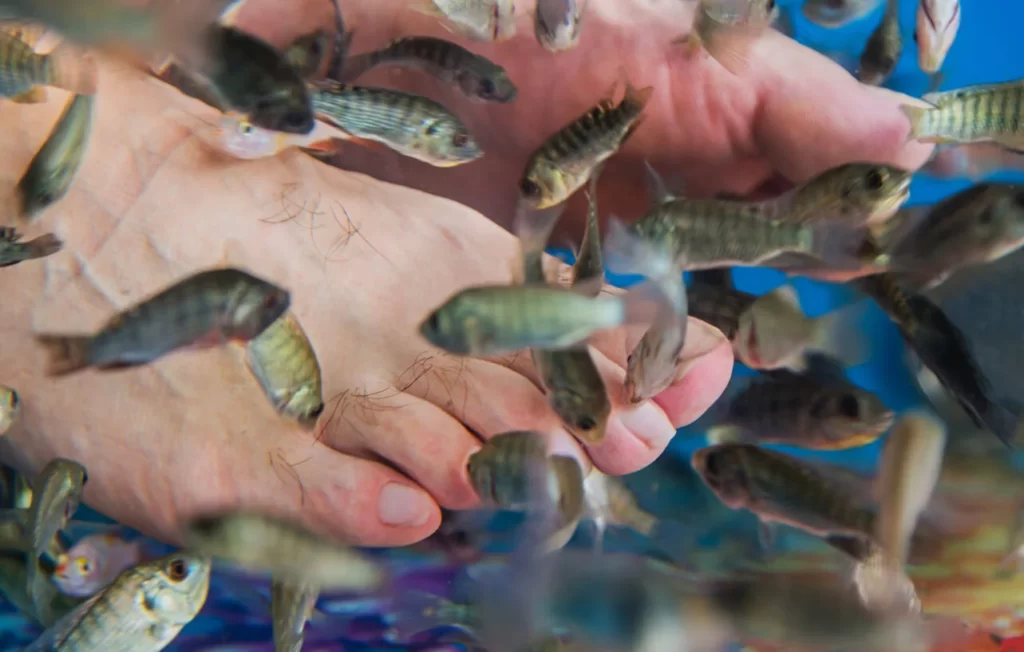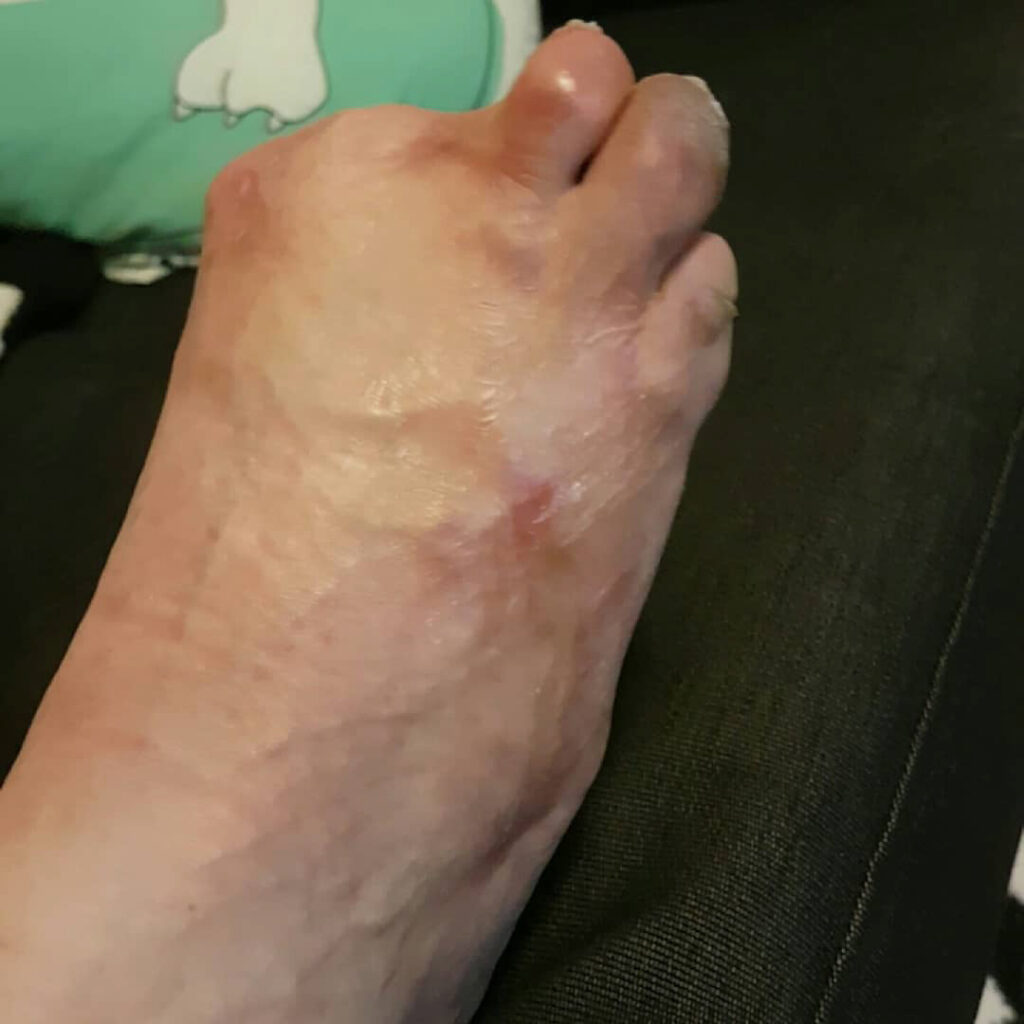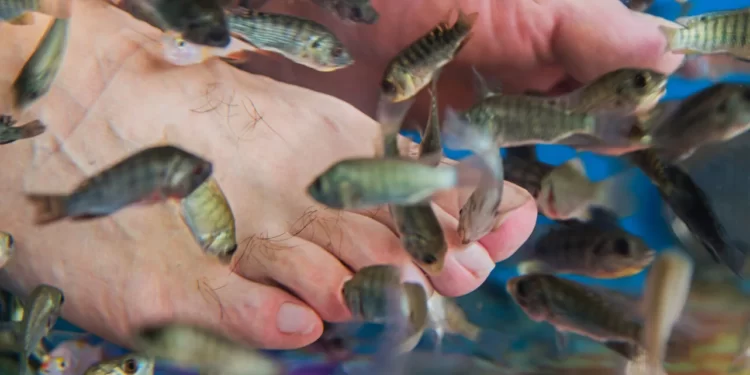Fish pedicures are a type of foot treatment that aims to give people soft skin. They are also known as fish spa treatments or ichthyotherapy. During the pedicure, a person soaks their feet in a basin of water, in which tiny “doctor fish,” or Garra rufa, are swimming. The fish will eat dead skin off the person’s feet.In some locations, it is possible to bathe in waters that naturally contain G. rufa. These freshwater fish originally come from the Middle East. In Turkey, some live in hot springs that have become popular health resorts.

Where did fish pedicures originate?
Ichthyotherapy originated in Kangal Fish Spring in Turkey, a spring located in Kangal, a district of the Sivas province
What do fish pedicures involve?
During a fish pedicure, a person first rinses their feet in warm water. Then, they sink their feet into a vat of water full of G. rufa fish. They soak their feet in the fish-filled tank, allowing the fish to nibble dead skin off their heels, soles, and toes. Afterward, the person removes their feet from the tank, and a spa technician dries them with a towel. The technician may remove any remaining dead skin and perform other aspects of the pedicure, such as trimming or filing the toenails. Which fish is used in fish pedicure? During a fish pedicure, also known as a fish spa treatment, customers place their feet in a tub of water filled with small fish called Garra rufa Garra rufa are sometimes referred to as “doctor fish” because they eat away dead skin found on people’s feet, leaving newer skin exposed.
Diseases due to fish pedicure
- Doctors are saying that fish foot spa may spread HIV and hepatitis! HOW IS THE INFECTION TRANSMITTED: The fish tank water contains micro-organisms from which the bacteria can be transmitted. The bacteria can also be transmitted from the spa water if the same water is used for more than one customer. If a person who is infected with HIV and/or Hepatitis (blood-borne viruses) bleeds in the water and the same water is used for another person, it can spread the infection. A growing number of these spas has lead the government to spread awareness about its potential risks.
- Onychomadesis can occur after a fish pedicure , which is when the toenails blacken and fall off. This is likely caused by trauma to the nail from the pressure of the fish. In at least one case, mycobacteriosis , a bacterial infection resulting in rough plaque on the skin, has been reported after a fish pedicure.
However, in G. rufa that come from fish spas, researchers have identified microbes that cause illness in both humans and fish. These include:
- Aeromonas veronii
- Aeromonas hydrophila
- Vibrio cholerae
- Shewanella putrefaciens
- Mycobacterium marinum
- Mycobacterium goodii
Recent cases
- 1 A 20-something woman began losing her toenails following a trendy fish pedicure, according to a new case study in the journal JAMA Dermatology. The woman was diagnosed with onychomadesis, a condition where the nail plate separates from the tissue under under your nail, halting its growth
- 2 A young woman from Australia lost all the toes on one of her feet after she had a “fish pedicure” is sharing her story and photos to warn other people about the dangers of “fish spas.”

Many states USA banned it
- Fish pedicures are super risky (and unsanitary), and are currently banned in 10 states in the U.S.
- California
- Florida
- Maine
- Massachusetts
- New Hampshire
- New Jersey
- New York
- Texas
- Washington
They are also illegal in Mexico, some countries in Europe, and some Canadian provinces.
Alternative ways to treat dry skin on the feet
There are many safe alternatives to fish pedicures that people can use to treat dry skin on the feet.
Home remedies include:
- soaking the feet in a tub of hot water and then buffing them with a pumice stone
- applying exfoliating foot creams, wearing socks, and sleeping through the night with the socks on
- using an electric dry skin and callus remover
Alternative treatments include:
- regular pedicures, which use warm foot soaks, scrubs, and pumice stones to remove dead skin
- professional foot peels, which use acids to exfoliate dead skin from the feet
- treatment by a podiatrist or chiropodist, who can remove dead or hard skin with special tools
Summary:
- Fish pedicures are a controversial type of foot treatment. During the pedicure, a person sits with their feet in a basin of water. Doctor fish, or G. rufa, eat the dead skin on their feet.
- Fish pedicures may pose a risk of causing infections, and some people argue that they are cruel. Overfarming G. rufa may also harm the environment.
- It’s better if you can avoid it
Fish pedicure centers country wise
Vietnam : ttps://www.tripadvisor.com/ShowUserReviews-g293924-d8692931-r518688333-Serene_Spa-Hanoi.html
Thailand : https://www.tripadvisor.com/ShowUserReviews-g293916-d6981327-r362266660-Phunnee_Massage-Bangkok.html



